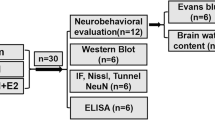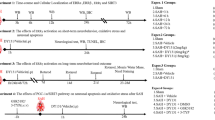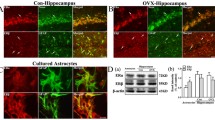Abstract
Our previous studies found that 17-β estradiol attenuates edema formation after intracerebral hemorrhage (ICH). As brain iron overload occurs after ICH and contributes to ICH-induced brain injury, the present study examined the effects of estrogen on iron-induced brain injury in vivo and in vitro.
There were two sets of experiments in this study. In the first set, male Sprague-Dawley rats were pretreated with 17-β estradiol or vehicle prior to an intracerebral injection of ferrous iron. Ferrous iron was injected into the right caudate and the rats were killed 24 h later for brain edema measurement. In the second set, primary cultured neurons were pretreated with different doses of 17-β estradiol or vehicle for 24 h. The cells were then exposed to ferrous iron for 48 h when culture medium was collected for lactate dehydrogenase measurement. Neuronal death was also assessed by live/dead cell assay.
Estrogen pretreatment reduced brain water content (p < 0.01) 24 h after iron injection. Estrogen also protected against iron-induced cell death in cultured neurons. Estrogen reduces iron-induced brain edema in vivo and neuronal death in vitro suggesting estrogen could be a potential therapeutic agent for ICH.
Access provided by Autonomous University of Puebla. Download conference paper PDF
Similar content being viewed by others
Keywords
1 Introduction
Iron, a hemoglobin degradation product, accumulates in the brain after intracerebral hemorrhage (ICH) (18). ICH-induced brain iron overload contributes to both early and delayed brain injury (5,10,11).
Estrogen has been shown to confer strong brain protection in experimental cerebral ischemia (7,17) and we have found that brain edema is reduced when estrogen is given before or after ICH (9,12). The mechanisms involved in estrogen-induced protection are unknown. The present study investigated whether or not estrogen reduces iron-induced brain edema in vivo and neuronal death in vitro.
2 Materials and Methods
2.1 Experimental Groups
There were two groups of experiments in this study. In the first group, male Sprague-Dawley rats were pretreated with 17-β estradiol (5 mg/kg) or vehicle at 24 and 2 h prior to an intracerebral injection of ferrous iron. Ferrous iron (0.2 mM, 50 µL) was injected into the right caudate and the rats were killed 24 h later for brain water content measurement. In the second group, primary cultured neurons were pretreated with different doses of 17-β estradiol (10 nM to 10 µM) or vehicle for 24 h. The cultured neurons were then exposed to ferrous iron (500 µM) for 48 h when culture medium was collected for lactate dehydrogenase (LDH) measurement. Neuronal death was also assessed by live/dead cell assay.
2.2 Animal Preparation and Intracerebral Injection
The University of Michigan Committee on the Use and Care of Animals approved the protocols for these animal studies, which used male Sprague-Dawley rats aged 3 to 4 months (Charles River Laboratories, Wilmington, MA). Septic precautions were used for all surgical procedures, and body temperature was maintained at 37.5°C using a feedback-controlled heating pad. Rats were anesthetized with pentobarbital (50 mg/kg, i.p.) and the right femoral artery was catheterized for continuous blood pressure monitoring and blood sampling. Blood from the catheter was used to determine pH, PaO2, PaCO2, hematocrit, and glucose. The animals were positioned in a stereotactic frame (David Kopf Instruments, Tujunga, CA). Ferrous iron was injected into the right caudate nucleus through a 26-gauge needle at a rate of 10 µL/min using a microinfusion pump (Harvard Apparatus, Inc., Holliston, MA). The coordinates were 0.2 mm anterior to bregma, 5.5 mm ventral, and 4.0 mm lateral to midline. After intracerebral injection, the needle was removed and the skin incision closed with suture.
2.3 Brain Water and Ion Content Measurements
Rats were killed under deep pentobarbital anesthesia at 24 h after iron injection. The brains were removed immediately and a 4-mm thick coronal section was taken 3 mm from the frontal pole. The brain sample was then divided into cortex or basal ganglia (ipsilateral or contralateral). Tissue samples were weighed to obtain the wet weight (WW). The tissue was then dried in a gravity oven at 100°C for more than 24 h to determine the dry weight (DW). Tissue water content (%) was calculated as ([WW−DW]/WW) × 100. Dehydrated brain samples were digested in 1 mL of 1 N nitric acid for 1 week. Sodium and potassium ion contents in this solution were measured by flame photometry and expressed in micro-equivalents per gram of dehydrated brain tissue (µEq/gm dry wt).
2.4 Primary Cortical Neuronal Culture
Neuronal cultures were established from embryonic day-17 Sprague-Dawley rat cerebral cortex. Cultures were prepared according to a previously described procedure with some modifications (8).
2.5 Measurement of Lactate Dehydrogenase
LDH activity in cell culture media was measured using a commercially available kit (Roche, Pleasanton, CA) according to the manufacture’s instructions. The activity of LDH in the medium was expressed as mU/mL.
2.6 Live/Dead Cell Assay
Cell viability was assessed using a commercial kit (Live/Dead Viability/Cytotoxicity assay kit, Molecular Probes, Eugene, OR) according to the manufacture’s instructions. Samples were viewed under a microscope. For each sample, four randomly spots were selected. Quantification of dead cells (percent of red cells/red + green cells) was performed by 1.62 NIH image system.
2.7 Statistical Analysis
All data in this study are presented as mean ± standard deviation. Data were analyzed with Student’s t test or ANOVA test. Significance levels were set at p < 0.05.
3 Results
Physiological variables including mean arterial blood pressure, blood pH, PaO2, PaCO2, hematocrit, and blood glucose level were controlled within normal ranges.
Intracerebral injection of ferrous iron caused brain edema in the ipsilateral basal ganglia (80.6 ± 0.9 vs. 78.2 ± 0.6% in the contralateral side, p < 0.05) at 24 h. Estrogen pretreatment reduced the water content (79.0 ± 0.3 vs. 80.6 ± 0.5% in the vehicle-treated group, p < 0.01, Fig. 1a) in the ipsilateral basal ganglia 24 h after iron injection. This was accompanied by a reduction in brain sodium content (239.9 ± 9.2 vs. 294.7 ± 67.7 µEq/g dry wt in the vehicle-treated group, p < 0.05, Fig. 1b) and reduced brain potassium loss (407.1 ± 27.7 vs. 458.7 ± 39.2 µEq/g dry wt in vehicle-treated group, p < 0.05, Fig. 1c).
Brain water (a), sodium (b) and potassium (c) contents in the ipsilateral (ipsi) and contralateral (contra) basal ganglia (BG) and cortex (Cx) 24 h after intracerebral injection of ferrous iron. Rats were pretreated with 17-β estradiol (E2; 5 mg/kg) or vehicle 24 and 2 h prior to ferrous iron injection. Values are mean ± SD, n = 5−7, *p < 0.05, #p < 0.01 vs. vehicle
Estrogen also protected against iron-induced cell death in cultured neurons. The LDH release induced by ferrous chloride was significantly reduced by 17-β estradiol pretreatment at all doses (e.g. at dose of 1 µM: 41 ± 7 vs. 58 ± 13 mU/mL in the vehicle-treated group, p < 0.05, Fig. 2a). In addition, iron-induced cell death (percentage to total cells) was less after 17-β estradiol treatment (p < 0.05, Fig. 2b).
(a) LDH levels in the neuronal culture medium 48 h after FeCl2 (500 µM) treatment. Neurons were pretreated with 17-β estradiol (E2) at different concentrations (0, 10 nM, 0.1 µM, 1 µM and 10 µM) for 24 h. Values are mean ± SD, *p < 0.05 and #p < 0.01 vs. E2 = 0. (b) 17-β Estradiol reduced neuronal death induced by FeCl2 (500 µM). Values are mean ± SD, *p <0.05 vs. vehicle
4 Discussion
Our previous study showed that 17β-estradiol attenuates ICH-induced brain edema (9). Perihematomal brain edema is commonly observed during the acute and subacute stage following ICH, contributing to poor outcomes (14,15,20). Although the mechanisms of edema formation following ICH are not fully resolved, several mechanisms are responsible for edema development. These include hydrostatic pressure during hematoma formation and clot retraction; coagulation cascade activation and thrombin production; erythrocyte lysis and iron toxicity (19). Iron has an important role in brain edema formation following ICH. We have demonstrated that deferoxamine, an iron chelator, can reduce perihematomal brain edema (11). In the present study we found that estrogen reduces iron-induced brain edema. The result suggests that estrogen-induced attenuation of brain edema following ICH may result from less iron toxicity.
Estrogen can also reduce iron-induced neuronal death. Recent studies have demonstrated that brain atrophy occurs after ICH in rats and in humans (5). Felberg et al. reported a 20% reduction in ipsilateral striatum volume and an increase in the ipsilateral ventricular size at 100 days after experimental ICH (2). Our data also found that brain atrophy develops gradually and peaks between 1 and 2 months after ICH in the rat and that deferoxamine can reduce ICH-induced brain atrophy implicating iron in such atrophy (5). Future studies should examine whether or not estrogen can reduce brain atrophy after ICH.
The precise mechanisms of estrogen-induced neuroprotection are not well understood, but estrogen reduces inflammation, diminishes programmed cell death and attenuates oxidative brain damage (3,4,6,16). There is also evidence that it can upregulate potentially protective heat shock proteins within the brain (1). Several estrogen receptors have been discovered including estrogen receptor (ER)-α, -β, -X and a membrane estrogen receptor (13). Evidence indicates that estrogen-induced neuroprotection can be estrogen receptor-mediated or non-estrogen receptor-mediated (13).
In summary, estrogen reduces brain edema and neuronal death induced by iron suggesting that acute use of estrogen could be a new therapy for ICH.
Conflict of interest statement We declare that we have no conflict of interest.
Reference
Behan M, Zabka AG, Mitchell GS (2002) Age and gender effects on serotonin-dependent plasticity in respiratory motor control. Resp Physiol Neurobiol 131:65–77
Felberg RA, Grotta JC, Shirzadi AL, Strong R, Narayana P, Hill-Felberg SJ, Aronowski J (2002) Cell death in experimental intracerebral hemorrhage: the “black hole” model of hemorrhagic damage. Ann Neurol 51:517–524
Garcia-Segura LM, Azcoitia I, DonCarlos LL (2001) Neuroprotection by estradiol. Prog Neurobiol 63:29–60
Gerlach M, Ben-Shachar D, Riederer P, Youdim MB (1994) Altered brain metabolism of iron as a cause of neurodegenerative diseases? J Neurochem 63:793–807
Hua Y, Nakamura T, Keep RF, Wu J, Schallert T, Hoff JT, Xi G (2006) Long-term effects of experimental intracerebral hemorrhage: the role of iron. J Neurosurg 104:305–312
Hurn PD, Brass LM (2003) Estrogen and stroke: a balanced analysis. Stroke 34:338–341
Hurn PD, Macrae IM (2000) Estrogen as a neuroprotectant in stroke. J Cereb Blood Flow Metab 20:631–652
Jiang Y, Wu J, Hua Y, Keep RF, Xiang J, Hoff JT, Xi G (2002) Thrombin-receptor activation and thrombin-induced brain tolerance. J Cereb Blood Flow Metab 22:404–410
Nakamura T, Hua Y, Keep RF, Park JW, Xi G, Hoff JT (2005) Estrogen therapy for experimental intracerebral hemorrhage in rats. J Neurosurg 103:97–103
Nakamura T, Keep RF, Hua Y, Hoff JT, Xi G (2005) Oxidative DNA injury after experimental intracerebral hemorrhage. Brain Res 1039:30–36
Nakamura T, Keep RF, Hua Y, Schallert T, Hoff JT, Xi G (2004) Deferoxamine-induced attenuation of brain edema and neurological deficits in a rat model of intracerebral hemorrhage. J Neurosurg 100:672–678
Nakamura T, Xi G, Hua Y, Schallert T, Hoff JT, Keep RF (2004) Intracerebral hemorrhage in mice: model characterization and application for genetically modified mice. J Cereb Blood Flow Metab 24:487–494
Rau SW, Dubal DB, Bottner M, Gerhold LM, Wise PM (2003) Estradiol attenuates programmed cell death after stroke-like injury. J Neurosci 23:11420–11426
Ropper AH (1986) Lateral displacement of the brain and level of consciousness in patients with an acute hemispheral mass. N Eng J Med 314:953–958
Ropper AH, King RB (1984) Intracranial pressure monitoring in comatose patients with cerebral hemorrhage. Arch Neurol 41:725–728
Santizo RA, Anderson S, Ye S, Koenig HM, Pelligrino DA (2000) Effects of estrogen on leukocyte adhesion after transient forebrain ischemia. Stroke 31:2231–2235
Wise PM, Dubal DB, Wilson ME, Rau SW, Bottner M, Rosewell KL (2001) Estradiol is a protective factor in the adult and aging brain: understanding of mechanisms derived from in vivo and in vitro studies. Brain Res – Brain Res Rev 37:313–319
Wu J, Hua Y, Keep RF, Nakamura T, Hoff JT, Xi G (2003) Iron and iron-handling proteins in the brain after intracerebral hemorrhage. Stroke 34:2964–2969
Xi G, Keep RF, Hoff JT (2006) Mechanisms of brain injury after intracerebral haemorrhage. Lancet Neurol 5:53–63
Zazulia AR, Diringer MN, Derdeyn CP, Powers WJ (1999) Progression of mass effect after intracerebral hemorrhage. Stroke 30:1167–1173
Acknowledgments
This study was supported by grants NS-017760, NS-039866, and NS-057539 from the National Institutes of Health (NIH), and 0755717Z and 0840016N from American Heart Asso-ciation (AHA). The content is solely the responsibility of the authors and does not necessarily represent the official views of the NIH or AHA.
Author information
Authors and Affiliations
Corresponding author
Editor information
Editors and Affiliations
Rights and permissions
Copyright information
© 2010 Springer-Verlag/Wien
About this paper
Cite this paper
Gu, Y., Xi, G., Liu, W., Keep, R.F., Hua, Y. (2010). Estrogen Reduces Iron-Mediated Brain Edema and Neuronal Death. In: Czernicki, Z., Baethmann, A., Ito, U., Katayama, Y., Kuroiwa, T., Mendelow, D. (eds) Brain Edema XIV. Acta Neurochirurgica Supplementum, vol 106. Springer, Vienna. https://doi.org/10.1007/978-3-211-98811-4_29
Download citation
DOI: https://doi.org/10.1007/978-3-211-98811-4_29
Published:
Publisher Name: Springer, Vienna
Print ISBN: 978-3-211-98758-2
Online ISBN: 978-3-211-98811-4
eBook Packages: MedicineMedicine (R0)






